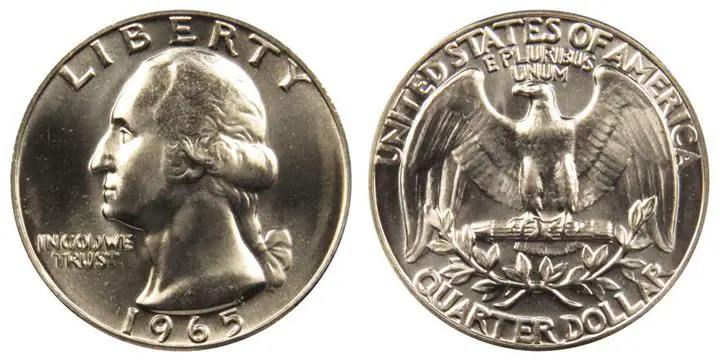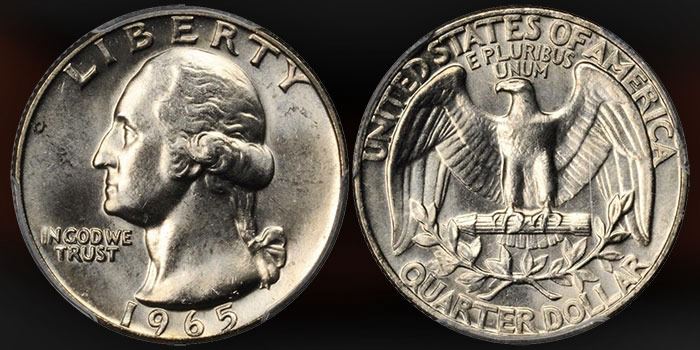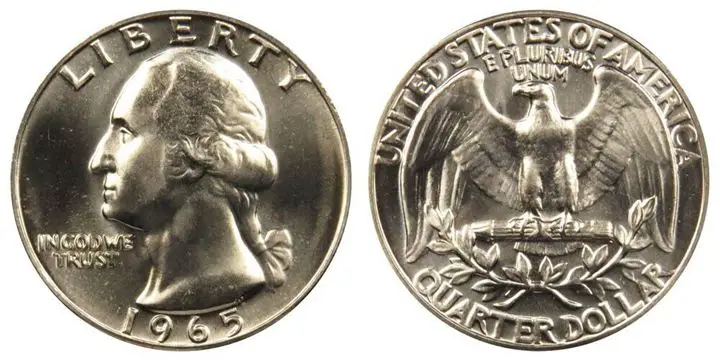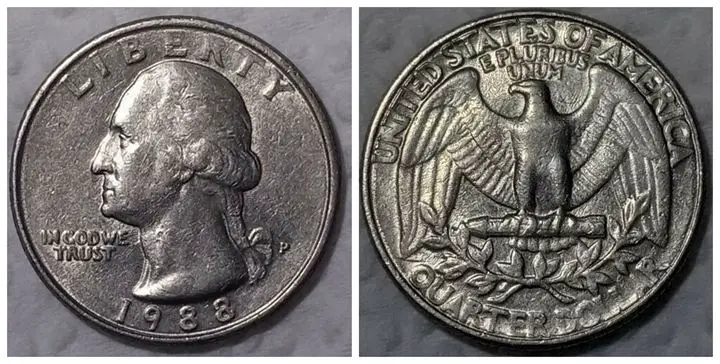In circulated condition, it is only worth the face value of $0.25. However, if the coin is in uncirculated condition, it can be worth as much as $10. The price goes up even more for coins that are in better condition. However, a rare 1965 silver quarter can be worth thousands of dollars!
1965 was an eventful year. The Vietnam War was in full swing, and the Beatles were wrapping up their iconic world tour. In the midst of all this turmoil, one event went largely unnoticed: the issuance of a new quarter.
For many people, collecting coins is a lifelong hobby. It can be a fun and rewarding way to spend your free time, and it’s also a great way to learn about history and numismatics. If you have a 1965 quarter lying around your house, you might be surprised to find out that it’s worth quite a bit more than 25 cents! In this blog post, we’ll tell you exactly how much a 1965 quarter is worth and what you can do with it. So, keep reading to learn more!
A Brief History of Washington Quarters
The Washington Quarter was first produced by the United States Mint in 1932, replacing the Standing Liberty Quarter. The coin was designed by John Flanagan and featured a portrait of George Washington on the obverse and an eagle on the reverse. The coin was produced to commemorate the 200th anniversary of Washington’s birth. The same design was used on the quarter until the 1970s, when the Mint began experimenting with different reverse designs.
George Washington is one of the most important figures in American history. He was the country’s first president, and his leadership during the Revolutionary War helped to secure the nation’s independence. He is also renowned for his honesty and integrity, virtues that have come to be associated with the “Father of Our Country.”
Indeed, Washington is so highly respected that his image has appeared on numerous coins and bills, including the 1965 quarter. Today, the Washington Quarter is one of the most popular coins in circulation and is a valuable addition to any collection.
What Does a 1965 Quarter Look Like?

In the midst of all the 1960s turmoil, the U.S. Mint made a major change to the composition of its quarters. Prior to 1965, quarters were made of a silver alloy that contained 90% silver and 10% copper. However, rising silver prices led the Mint to switch to a clad composition that contained copper and nickel. As a result, 1965 quarters have 0% silver content.
The 1965 quarter is notable for its obverse, which features a head of George Washington facing left, with “Liberty” above the head, the date below, and “In God We Trust” on the left. On the reverse there is an eagle with wings spread perches on a cluster of arrows, with two olive branches serving as its background. None of the 1965 quarters have mint marks. All were minted in Philadelphia.
How Rare is a 1965 Washington Quarter?
Is a 1965 quarter worth anything and how rare is it?
According to the United States Mint, over 1,819,717,540 1965 Washington Quarters were minted. This high mintage number makes the 1965 Quarter one of the most common dates in the quarter series. However, the actual number of surviving coins is much lower. Many of these coins were heavily circulated and showed significant wear. Others were lost or damaged over the years.
While the 1965 Quarter is not rare in absolute terms, it is much less common than its mintage would suggest. For this reason, it remains a popular choice with collectors.
What is the 1965 Quarter Value?
The value of a 1965 quarter depends on a number of factors, but the most important factor is its condition. If the coin is circulated, it will only be worth its face value. However, if the coin is in mint condition, it could be worth significantly more.
The Sheldon Scale is a 70-point coin grading system that is used to assess the condition of a coin. The scale was developed by Dr. William Sheldon in 1949 and is currently the most widely used grading system in the United States. coins are assigned a grade from 1 to 70, with 1 being the lowest and 70 being the highest. The Sheldon Scale is an essential tool for collectors and dealers, as it provides a standard way to assess the value of a coin.
| Grade of the 1965 Quarter | Value |
| MS 62 | $2-$3 |
| MS 63 | $2-$4 |
| MS 64 | $3-$5 |
| MS 65 | $6-$10 |
| MS 66 | $13-$21 |
| MS 67 | $32-$53 |
| MS 68 | $49-$81 |
| PR 67 | $38-$63 |
An MS 62 coin is an uncirculated coin with noticeable deficiencies, like an overabundance of bagmarks, a poor strike, or poor luster. These coins are generally worth $2-$3.
An MS 63 coin also has a mint luster that may be slightly impaired, but it doesn’t have as many noticeable deficiencies as an MS 62 coin. These coins are generally worth $2-$4.
When it comes to MS 64 coins, the strike is important. A full mint luster is not required, but bagmarks should be kept to a minimum. This coin is worth $3-$5.
On the other hand, an MS 65 coin should have no distracting marks or imperfections. At this point, mint luster is expected to be full. This coin can be worth $6-$10.
In the world of coin collecting, MS 66 and MS 67 are two of the most coveted grades. Both denote a high quality of surface and mint luster, with only a few minor contact marks. However, an MS67 coin is even rarer. While an MS66 coin is typically worth $13-$21, an MS67 coin can be worth upwards of $32-$53.
MS 68 coins are particularly desirable, as they boast a beautiful sharp strike and full original luster. This condition is extremely rare, making MS-68 coins worth $49-$81.
PR 67 coins are also highly sought-after, as they are virtually as struck with only minor imperfections. These coins can be worth $38-$63.
Is There a 1965 Silver Quarter?
In the early 1960s, the price of silver began to rise sharply, driven by a combination of factors including government purchases, speculation, and industrial demand. The resulting “silver crisis” led to a sharp decrease in the value of the dollar and a series of financial crises that affected countries around the world. In an effort to stabilize the situation, several governments began selling off their silver reserves, driving the price down further.
In an effort to save on silver expenditures, the United States Mint stopped using silver in their dimes and quarters. Instead, these coins were made of a copper-nickel alloy. This change caused some errors to occur during production, resulting in a small number of silver quarters being produced. These so-called “transition quarters” are highly prized by collectors and can be worth a significant amount of money. While the odds of finding one of these quarters are slim, it’s still fun to keep an eye out for them when you’re handling your change.
In conclusion, yes – there are many examples of quarters being struck on leftover 90% silver planchets and they can be worth a small fortune!
How To Tell if a 1965 Quarter Is Silver?
The 1965 silver quarter is a valuable coin that any numismatist would be happy to add to their collection. However, before you can begin searching for this elusive coin, it is important to know how to identify it.
One way to do it is to take a look at the reeded edge of the coin. You should see one solid color; if you see a layered center, then you have an counterfeit coin. Silver quarters have a glossier surface and no copper or nickel layers that protrude from the coin’s edge.
Because the coin was made of 90% silver, it is significantly heavier than more recent quarters that are made of copper and nickel. To determine if a quarter is made of silver, the easiest way is to use a coin scale that can measure down to the hundredth of a gram. All 90% silver Washington quarters weigh 6.25 grams (give or take a few hundredths of a gram). All copper-nickel clad Washington quarters weigh 5.67 grams (give or take a few hundredths of a gram). If your quarter weighs something different, it’s not a genuine Washington quarter.
Finally, take the coin to a professional numismatist or coin dealer for authentication. While this may cost you a small fee, it’s worth it to ensure that you don’t miss out on a potentially lucrative find.
How Much is a 1965 Silver Quarter Worth?
The 1965 silver quarter is a highly sought-after coin, and it’s not hard to see why. Minted in 90% silver, it’s one of the last circulating coins to be made with precious metal. As a result, Mint State examples of the 1965 silver quarter can sell for more than $7,000. But even circulated coins are worth well above face value, making the 1965 silver quarter an excellent choice for any collector or investor.
Are There Any Other 1965 Quarter Error Coins?

In numismatics, a coin error is a mistake in the manufacturing process of a coin. Now we know that the most valuable errors are 1965 silver quarters and they can reach the price of. But are there any other errors in the 1965 Washington quarter and what is their value?
Other than the previously mentioned 1965 quarter errors, there are also coins with a doubled die obverse and a doubled die reverse. These coins have a defect in the die that caused the image to be imprinted twice on the coin. As a result, these quarters have a blurry or doubled appearance.
One type of error is a strike on two staples coins. This occurs when a blank coin, which is supposed to be fed into a press to be struck with a design, gets fed through twice and is struck on two staples. As a result, the coin has two designs side by side.
In addition, some 1965 quarters were struck off-center, meaning that the blank coin was not centered correctly before it was struck by the die. This results in the image being imprinted on only part of the coin.
Finally, there are also quarters that were struck on a wrong planchet. This happens when a blank coin of a different denomination is fed into the press by mistake. For example, a 1965 dime planchet may have been fed into the quarter press, resulting in a quarter that is smaller than normal.
While most of these coins are considered errors, they can be valuable to collectors and are worth more than regular quarters.
How to Find the Value of Your 1965 Washington Quarter Coins
Trying to find the value of your 1965 Washington quarter coins can be a difficult task. There are a variety of factors that can affect the price, including condition, mint mark, and whether the coin is rare.
If you have a 1965 Washington Quarter coin, then you might be wondering how much it is worth. There are a few things that you can do in order to determine the value of your coin.
Compare to Recently Sold Prices
The best way to determine the value of your coins is to compare them to recently sold prices. This will give you a good idea of what others are willing to pay for similar coins. You can find recent sale prices online on websites like eBay. For example:
- A PR 63 1965 Washington quarter sold for $14.
- Uncirculated proof-like 1963 Washingtong quarter sold for almost $6.
- A circulated 1965 quarter no mint mark sold for $10.
If you believe you have a special silver coin or any other unique features on your 1965 quarter, you should first get it appraised and graded by a professional before comparing it to similar pieces that have sold on previous auctions.
- 1965 Washington quarters struck on silver coin planks sell for more than $8000!
- A 1965 Washington Quarter struck on two staples sold for a little above $1400.
- A 1965 Washington quarter struck without a collar die graded MS 66 sold for more than $1000.
- A Washington quarter struck on a 5 cent planchet graded MS 62 sold for $373.
Consult Official Price Guides
You should consult official price guides to get an accurate estimate of your coin’s value. These guides list recent sales prices for similar coins, so you can get a good idea of what your coin is worth.
While some coin dealers may try to take advantage of inexperienced collectors, there are a few reputable sites that can give you an idea of what your coin is worth. The PCGS Price Guide and the NGC Price Guide are two good sources of information. Here, you can find information about recent sales and trends in the coin market. By using these resources, you can get a good idea of the value of your 1965 quarter value.
Get it Appraised
The best way to determine the value of your coin is to take it to a professional appraiser who can inspect it and give you an accurate estimate. The first step is to get them appraised by a professional. This will give you a general idea of their value and help you determine whether they’re worth selling or keeping.
Appraisers will take into account the coin’s condition, rarity, and age when determining its value. They may also look at market trends to see how much similar coins have sold for in the past. Once you have an appraisal, you can then decide whether to sell your coins or keep them as part of your collection.
What is the Most Expensive 1965 Quarter Ever Sold?
In 2014, a 1965 quarter struck on a 90% silver planchet and graded AU 58 PCGS by Professional Coin Grading Service sold at an auction for $14,687.50. This made it the most expensive 1965 quarter ever sold. The coin was struck at the Philadelphia Mint and is considered to be borderline uncirculated. It is one of only a few known examples of this type of coin.
Helpful Resources
Here are some helpful resources that you can use to determine is a 1965 quarter worth anything:
- The Everything Coin Collecting Book: All You Need to Start Your Collection And Trade for Profit by Richard Giedroyc
- A Guide Book of United States Coins 2022 75th Edition
- Coin Collecting For Beginners: The Easy and Ultimate Guide for Newbies to Start Your Own Coin Collection From Scratch as a Fun Hobby to Share With Family & Friends or as a Profitable Business Paperback by Eldridge Calford
- Official ANA Grading Standards for United States Coins (Official American Numismatic Association Grading Standards for United States Coins) by Kenneth Bressett
- Cherrypickers’ Guide to Rare Die Varieties of United States Coins (An Official Whitman Guidebook)
FAQ
Are 1965 quarters with no mint mark valuable?

Some people believe that the 1965 quarter no mint mark is more valuable, the reality is that mint marks have no bearing on a coin’s value – at least in the case of a 1965 quarter. Instead, what matters is the coin’s condition and rarity.
Does a 1965 quarter have any silver?
The answer is no – all quarters minted after 1964 are made of copper and nickel. However, there are some 1965 quarters that are considered error coins, as they were accidentally made with 90% silver instead of the standard copper-nickel composition. These coins are extremely rare and can be worth thousands of dollars. So, if you have a 1965 quarter, it’s definitely worth checking to see if it’s one of these valuable error coins!
What is a spitting eagle quarter?

The spitting eagle quarter is a die variety of the 1983-P Washington Quarter. The variety is identified by a die crack: a raised line caused by the deterioration of a coining die, near the mouth of the eagle on the reverse. The die crack appears as a raised line on the coin, and it extends from the bottom of the beak to the edge of the coin. This variety is relatively rare, and it is highly sought after by collectors.
The Spitting Eagle coin is a highly coveted item among collectors. In the past 12 years, prices for the coin have ranged from $63 to $152, with the highest grades (MS 65 and MS 66) fetching the highest prices.
What are transitional error coins?
Transitional error coins are those that are struck on a planchet from a previous year with a different metal composition. For example, in 1964, the United States changed the composition of its quarter from 90% silver to a copper-nickel alloy. However, a small number of quarters were struck on 1964-dated silver planchets that were left over from the previous year. These coins are known as transitional errors and they are highly prized by collectors.
Transitional errors can also occur when a coin is struck on a planchet that has been incorrectly milled. For example, in the early 1990s, the U.S. Mint began producing dimes and quarters on planchets that were smaller in diameter than those used in previous years, but a small number of these smaller-sized coins were struck on full-sized planchets.
Can silver coins be melted down?
The answer is yes – in the United States, there are no laws against melting, destroying, or modifying any coins. So, if you have a few old silver coins that you no longer want, you can melt them down without worrying about breaking the law. However, if you have a 1965 silver coin, it’s worth more than the melt value.
What year of quarters are worth keeping?
While all quarters are worth at least 25 cents, some quarters are worth much more. Quarters dated 1964 and earlier are 90% silver and therefore worth many times their face value. For example, a quarter dated 1964 is currently worth about $7.00.
Of course, the value of these quarters can fluctuate depending on the current market conditions. However, if you have any quarters dated 1964 or earlier, it is definitely worth hanging onto them. You never know when their value might go up!
Final Thoughts
So, how much is a 1965 quarter worth? There is no easy answer. The value of a 1965 quarter depends on its condition and whether it is made of silver or copper-nickel. In circulated condition, the coin is only worth its face value of $0.25. However, if the coin is in uncirculated condition, it can be worth as much as $10. The price goes up even more for coins that are in better condition. A rare 1965 silver quarter can be worth thousands of dollars!
We hope that you found our guide helpful in understanding the value and history of this coin. Thank you for reading!
